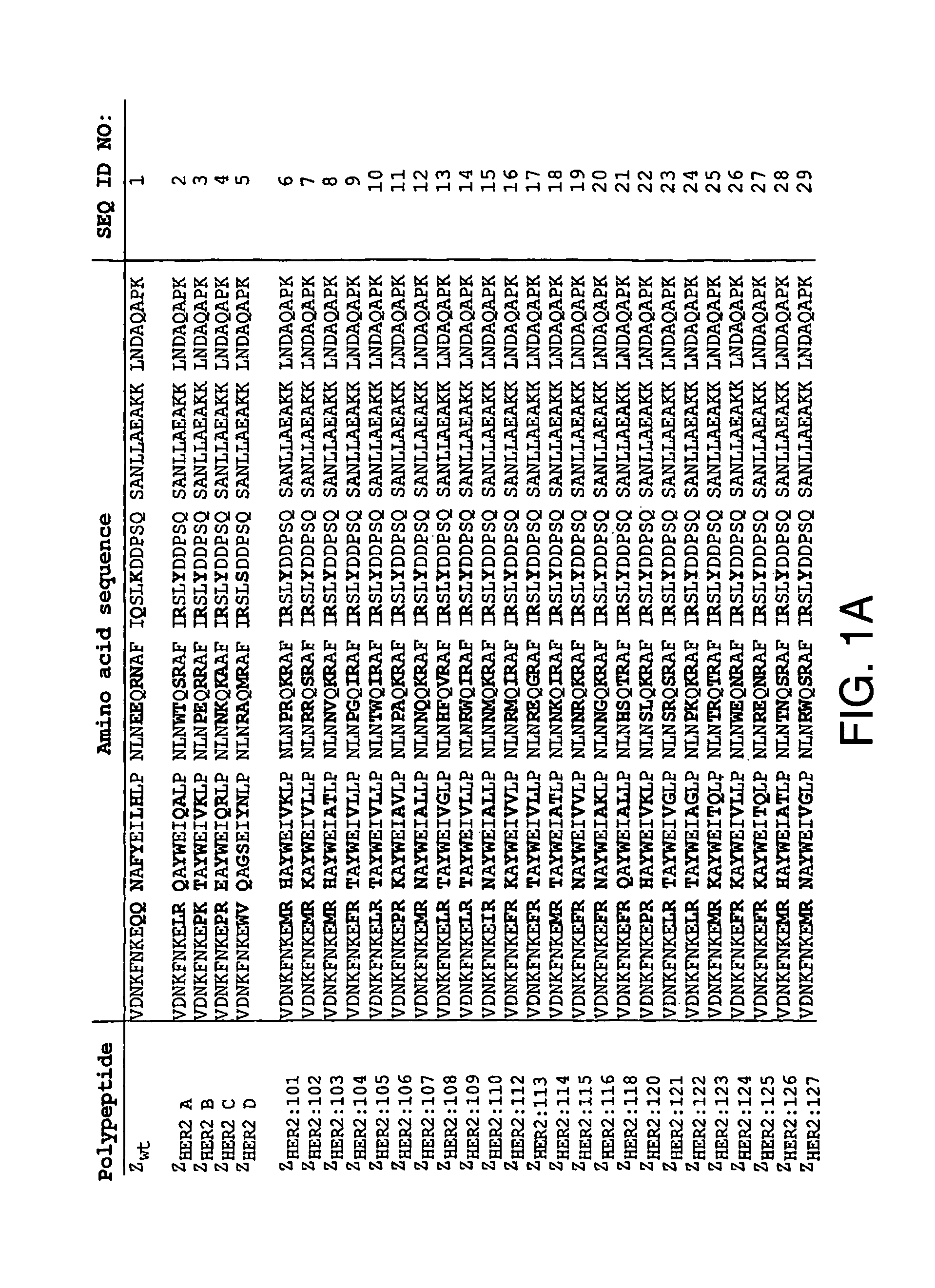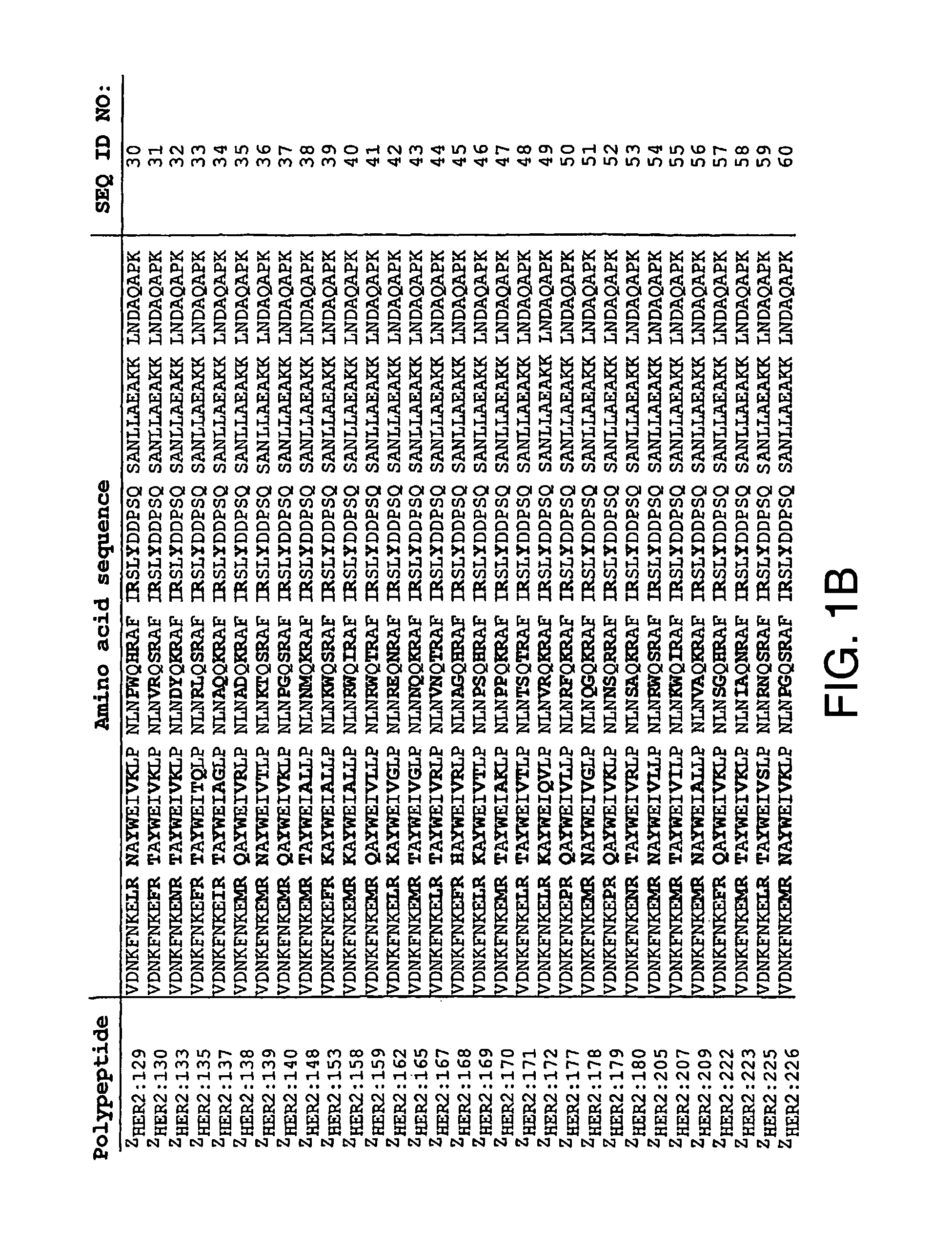Polypeptides having binding affinity for HER2
a polypeptide and her2 technology, applied in the field of polypeptides, can solve the problems of increased cell division, concomitantly higher cell growth rate, and her2 protein overexpression on the surface of these tumor cells, and achieve the effect of improving the her2 binding capacity of the polypeptid
- Summary
- Abstract
- Description
- Claims
- Application Information
AI Technical Summary
Benefits of technology
Problems solved by technology
Method used
Image
Examples
example 2
Binding of ZHER2 A to Cells Expressing HER2
Cell Culture
[0118]The human breast cancer cell line SKBR-3, known to express about 2×106 HER2 molecules per cell, was purchased from ATCC (ATCC #HTB-30). The cells were cultured in RPMI 1640 medium supplemented with 10% fetal bovine serum, 2 mM L-glutamine, and PEST (100 IU / ml penicillin and 100 μg / ml streptomycin), all from Biochrom KG (Berlin, Germany). The cells were cultured at 37° C. in humidified air containing 5% CO2, and seeded in 3 cm petri dishes three days before the experiment.
Radiolabeling
[0119]Labeling precursor, N-succinimidyl p-(trimethylstannyl)benzoate (SPMB), was prepared according to Orlova et al in Nucl Med Biol 27:827-835 (2000), and 5 μg of SPMB was added to 5 MBq of 125I in a 5% solution of acetic acid. To start the reaction, 40 μg of chloramine-T (Sigma, St. Louis, Mo.) in aqueous solution was added. The reaction mixture was agitated for 5 min, and 80 μg of sodium-meta-bisulphate (Aldrich, Steinheim, Germany) in aqu...
example 3
Expression and Characterization of Dimers of HER2 Binding Polypeptides
DNA Construction and Protein Production
[0122]The selection of a novel affibody ligand, denoted His6-ZHER2 A and having affinity for the HER2 receptor, was described above. A dimeric ZHER2 variant was constructed by subcloning the gene fragment encoding the ZHER2 A polypeptide into the expression vector for His6-ZHER2 A. The introduced ZHER2 A fragment was verified by DNA sequencing on a DNA sequencer ABI Prisms 3700 Analyzer (Applied Biosystems, Foster City, Calif.). The Escherichia coli strain RR1ΔM15 (Rüther, Nucleic Acids Res 10:5765-5772 (1982)) was used as bacterial host during the cloning procedure. The resulting vector encodes, under the control of the T7 promoter (Studier et al, Methods Enzymol 185:60-89 (1990)), a dimeric ZHER2 variant, (ZHER2 A)2, fused to an N-terminal hexahistidyl (His6) tag, which allows purification by immobilized metal ion affinity chromatography (IMAC).
[0123]The dimeric ZHER2 varia...
example 4
Biodistribution and Tumor Targeting with (ZHER2 A)2 in Nude Mice Bearing SKOV-3 Xenografts
[0127]In the experiments making up this example, the His6-tagged dimeric (ZHER2 A)2 polypeptide according to Example 3 was radiolabeled with 125I and injected into mice bearing a grafted tumor characterized by HER2 overexpression. Studies of the biodistribution of the polypeptide were conducted, as well as imaging of the injected mice to study localization of the labeled polypeptide. A labeled Z domain derivative with binding affinity for Taq DNA polymerase was used as control without specificity for HER2 (ZTaq; described in Gunneriusson E et al, supra and referred to therein as ZTaq S1-1).
Materials and Methods
Indirect Radioiodination of (ZHER2 A)2
[0128]A volume of 2.3 μl 125I (corresponding to 10 MBq) (Na [125I], Amersham Biosciences, Uppsala, Sweden) was added to a siliconized microcentrifuge tube. 10 μl acetic acid (0.1% in water), 5 μl N-succinimidyl p-trimethylstannyl-benzoate (1 mg / ml in...
PUM
| Property | Measurement | Unit |
|---|---|---|
| volume | aaaaa | aaaaa |
| volume | aaaaa | aaaaa |
| volume | aaaaa | aaaaa |
Abstract
Description
Claims
Application Information
 Login to View More
Login to View More - R&D
- Intellectual Property
- Life Sciences
- Materials
- Tech Scout
- Unparalleled Data Quality
- Higher Quality Content
- 60% Fewer Hallucinations
Browse by: Latest US Patents, China's latest patents, Technical Efficacy Thesaurus, Application Domain, Technology Topic, Popular Technical Reports.
© 2025 PatSnap. All rights reserved.Legal|Privacy policy|Modern Slavery Act Transparency Statement|Sitemap|About US| Contact US: help@patsnap.com



